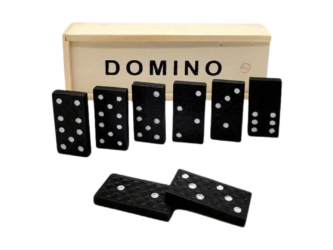Dominoes
Dominoes
Dominoes is one of the oldest and most popular games around the world, offering a blend of strategy, skill, and fun. It’s a game that transcends cultures, ages, and skill levels, making it a staple at family gatherings, social events, and competitive tournaments alike. Whether you’re a seasoned player or someone who’s just learning the rules, understanding the basics and nuances of Dominoes can make the game even more enjoyable. In this article, we’ll explore the history of Dominoes, its basic rules, popular variations, and tips to improve your game.
The History of Dominoes
Dominoes has a rich history that dates back over 1,000 years, with its origins rooted in China around the 12th century. The game made its way to Europe in the 18th century, gaining popularity in Italy and eventually spreading throughout Europe and the Americas. The simple yet engaging nature of Dominoes has allowed it to evolve and adapt to different cultures, giving rise to a variety of gameplay styles worldwide.
Basic Rules of Dominoes
Dominoes is typically played with a set of rectangular tiles, each divided into two squares, with a number of dots (called “pips”) on each half. A standard set consists of 28 tiles, ranging from blank tiles (no pips) to tiles with six pips on each side, known as a double-six set.
Here’s how a basic game of Dominoes works:
- Setup: Dominoes can be played by two to four players. The tiles are shuffled and placed face down on the table. Each player draws a certain number of tiles, usually 7 for a two-player game and 5 for a four-player game.
- Gameplay: The player with the highest double (a tile with the same number of pips on both sides, like 6-6 or 5-5) places it in the center. From there, players take turns adding tiles that match the pips on the open ends of the domino chain.
- Matching and Scoring: Players must match the number of pips on one side of their tile to the open end of the domino chain. If a player cannot make a move, they must draw tiles from the remaining pile (or pass, depending on the variation). The game continues until one player uses all their tiles or no more moves can be made. The winner is the player with the fewest pips remaining in their hand, or the player who goes out first.
- Scoring: In some versions, points are awarded for certain moves, and the first player to reach a predetermined score (such as 100 or 150 points) wins the game.
Popular Variations of Dominoes
While the basic game is easy to learn, there are many variations of Dominoes that add layers of strategy and excitement. Some of the most popular variations include:
- Block Dominoes: This is the simplest and most common form of the game. In Block Dominoes, players cannot draw extra tiles. If a player cannot make a move, they must pass. The game continues until no moves are possible, and the player with the lowest total pips wins.
- Draw Dominoes: Similar to Block Dominoes, but in this version, players can draw extra tiles from the boneyard (the leftover tiles) if they cannot make a move. The game ends when a player goes out or no more moves are available.
- Mexican Train: A popular variation that involves more strategy and can be played with more players. In Mexican Train, each player builds their own personal train of tiles, and there’s also a communal “Mexican train” that anyone can play on. The goal is to be the first to play all of your tiles.
- All Fives (Muggins): In this variation, players score points whenever the total number of pips at the open ends of the domino chain is a multiple of five. This adds a scoring element that makes the game more strategic.
- Double Nine, Twelve, or Fifteen Dominoes: These variations use larger sets of tiles, increasing the game’s complexity and allowing more players to join. They follow similar rules to the basic game but with more possible combinations and strategies.
Tips to Improve Your Dominoes Game
While Dominoes may seem like a game of chance at first, it actually involves a lot of strategy, especially in advanced variations. Here are some tips to improve your Dominoes gameplay:
- Pay Attention to the Board: Always keep an eye on the numbers that have been played. This helps you predict what tiles your opponents might have and make better strategic decisions.
- Control the Game: If possible, try to control the board by playing doubles or high-number tiles early. This can limit your opponents’ options and force them to draw tiles.
- Balance Offense and Defense: While it’s tempting to focus solely on getting rid of your tiles, sometimes it’s smarter to play defensively. Blocking your opponents’ moves can give you the advantage, especially in competitive games like All Fives.
- Hold on to Versatile Tiles: Tiles with numbers that appear frequently, such as 5-3 or 6-4, are versatile and can be useful in multiple situations. Try to keep these tiles for when you need them.
- Plan Ahead: As in any strategic game, planning your moves a few turns ahead is crucial. Think about the consequences of placing a tile and how it might benefit your opponents.
Why Dominoes is Still Popular Today
The enduring popularity of Dominoes can be attributed to its simplicity, versatility, and the way it combines luck with strategy. It’s a game that’s easy to learn but offers enough depth to keep players engaged for years. Whether played casually with friends or competitively in tournaments, Dominoes remains a beloved pastime across the globe.
Moreover, Dominoes is more than just a game – in many cultures, it’s a social event. Families, friends, and even strangers gather around a Dominoes table, not just to play but to bond, talk, and enjoy each other’s company. This social aspect has helped the game maintain its appeal through the centuries.
Conclusion
Dominoes is much more than a simple tile game. Its rich history, diverse variations, and blend of strategy and chance make it a timeless classic that continues to entertain players of all ages. Whether you’re playing for fun at a family gathering or competing in a serious match, Dominoes offers endless opportunities for enjoyment and challenge. With a bit of practice and strategic thinking, you can master the art of Dominoes and discover why this ancient game remains as popular as ever.












